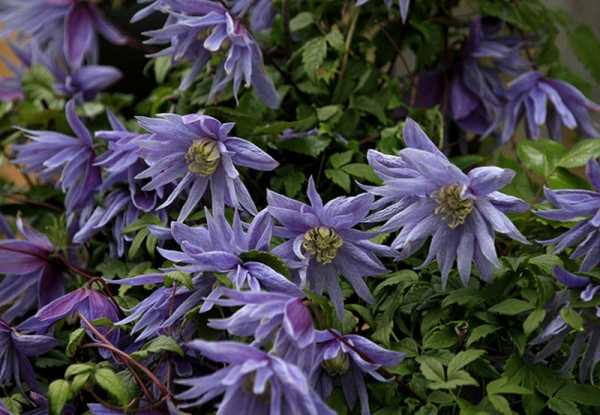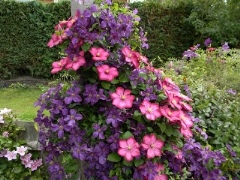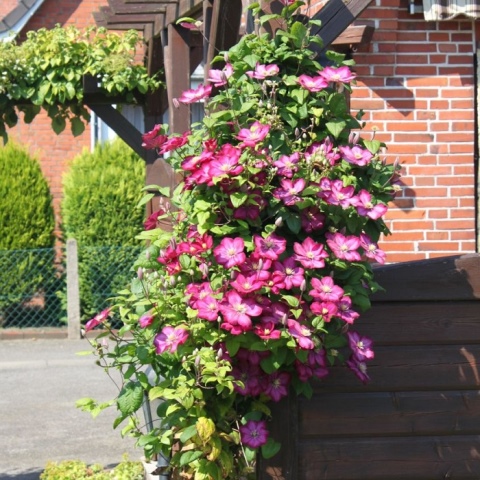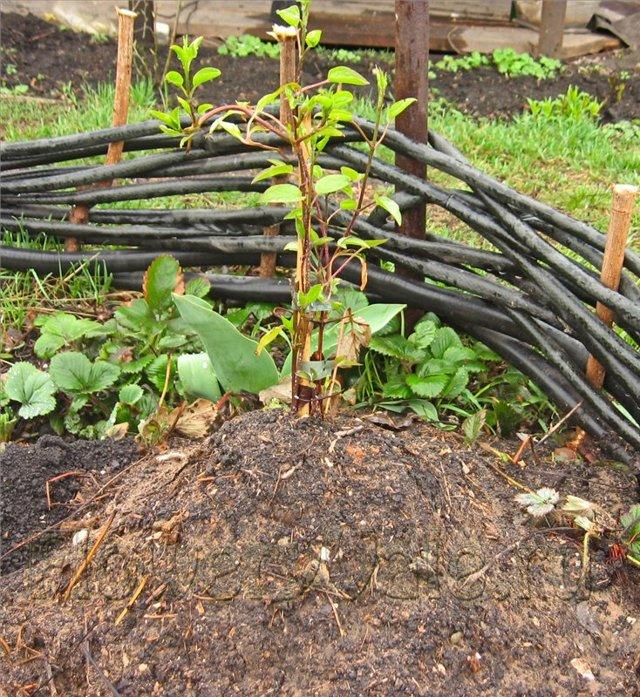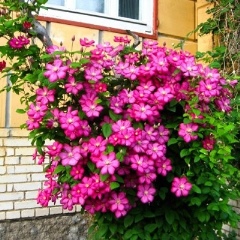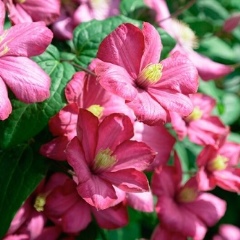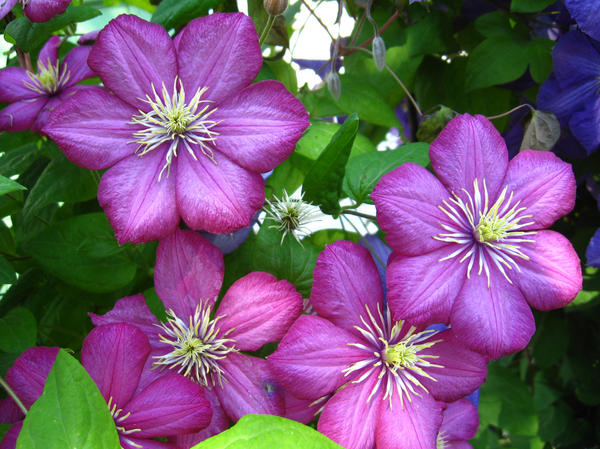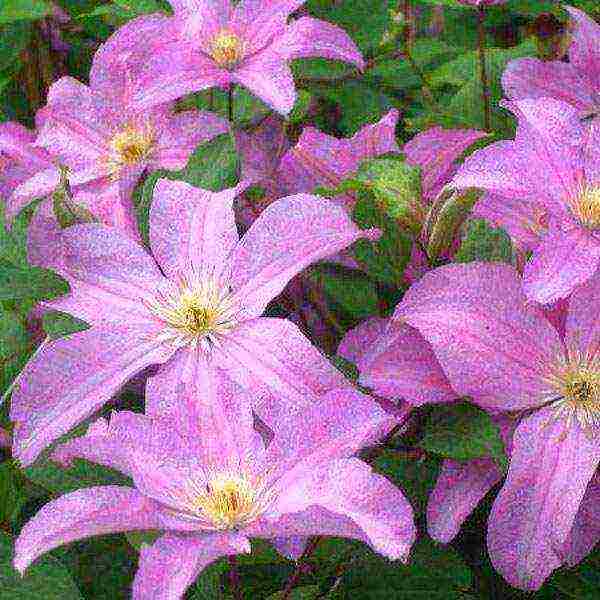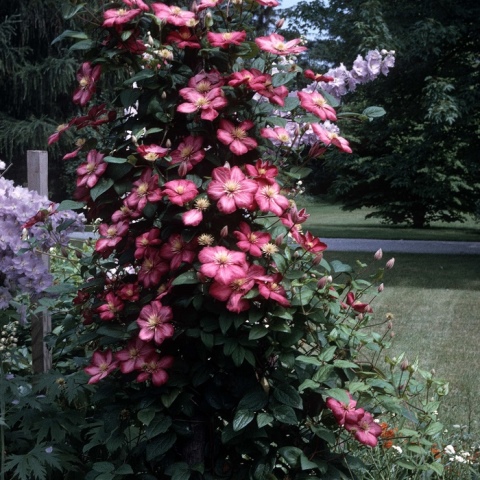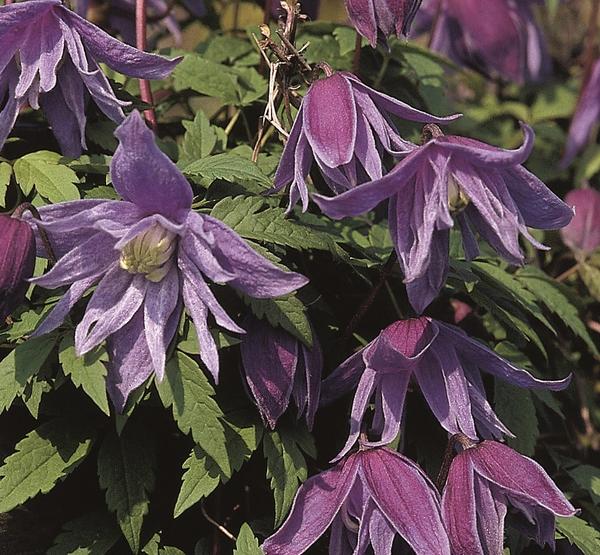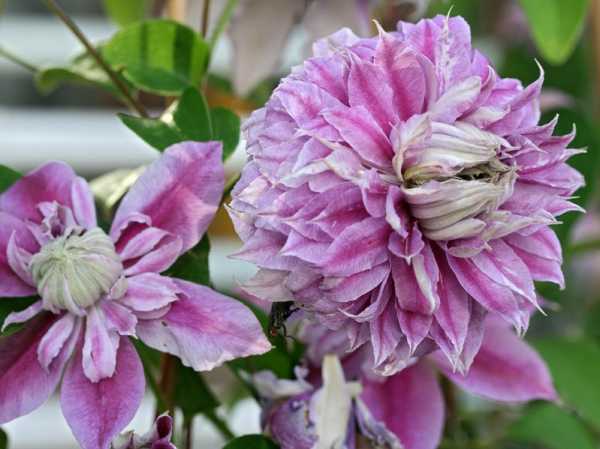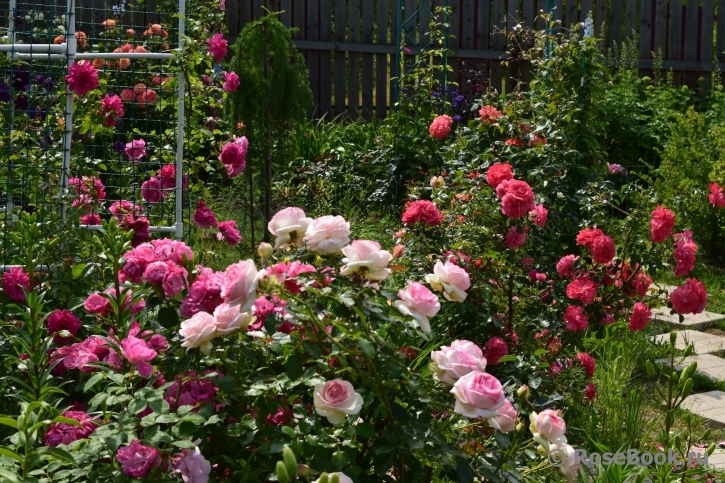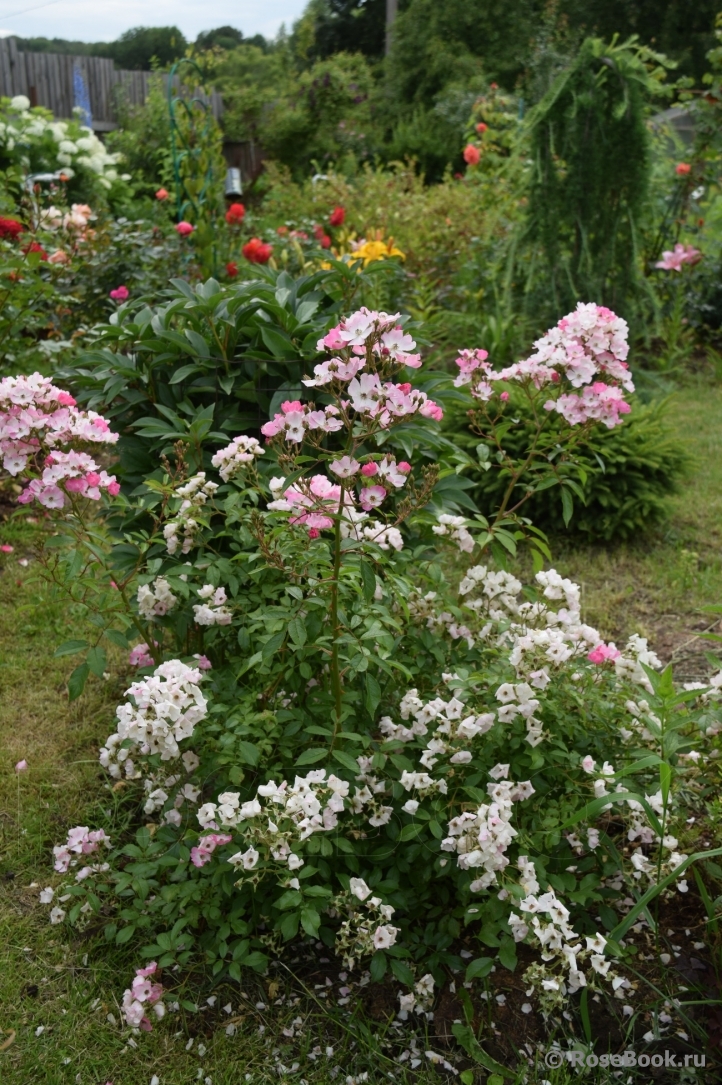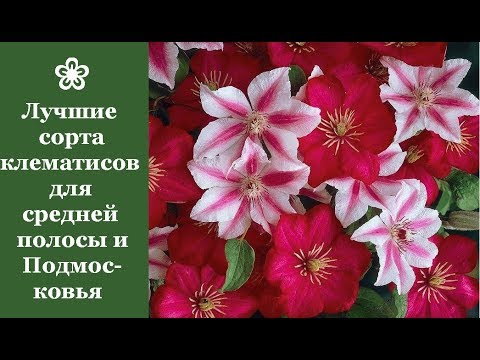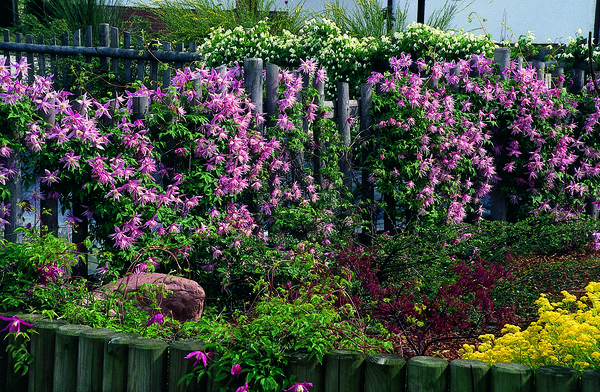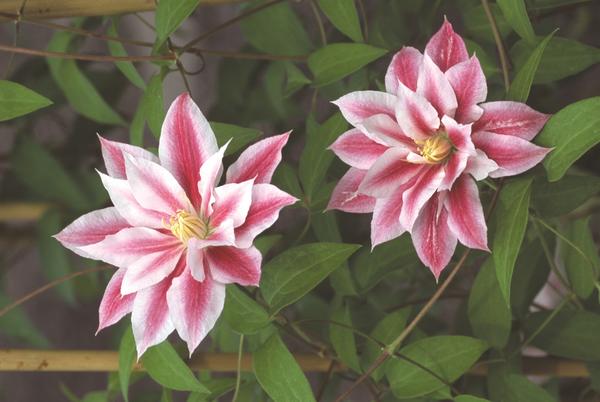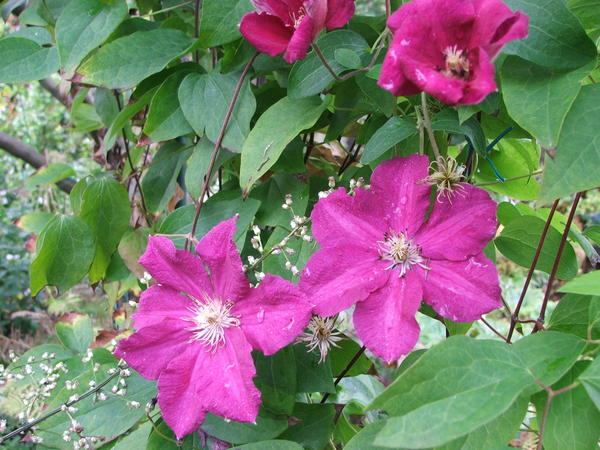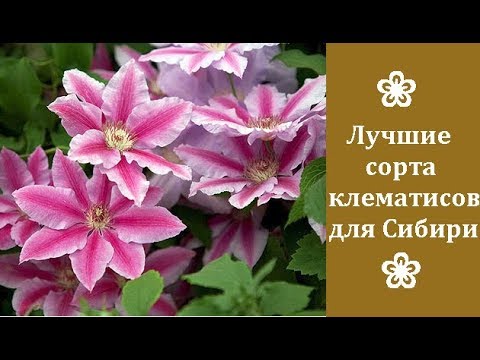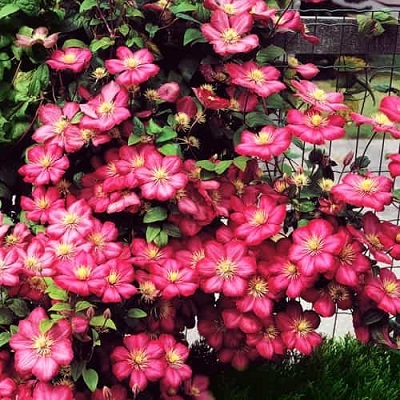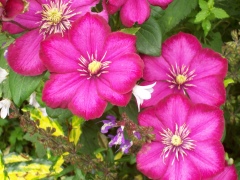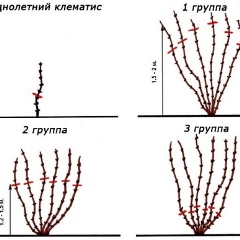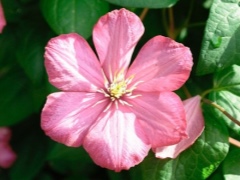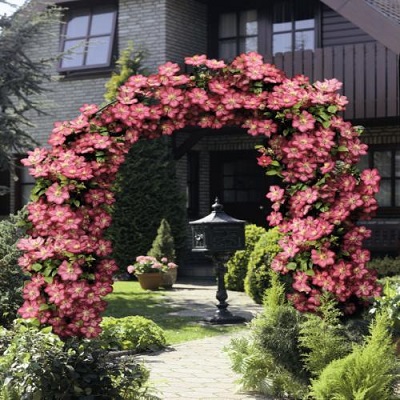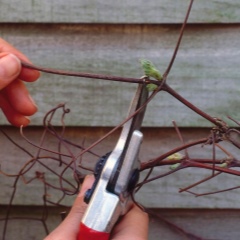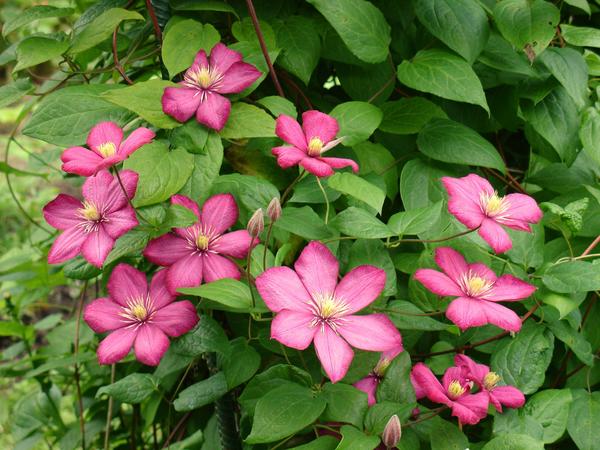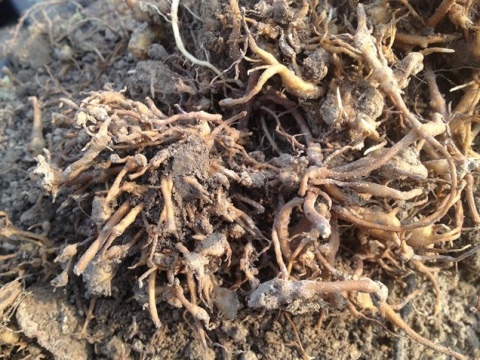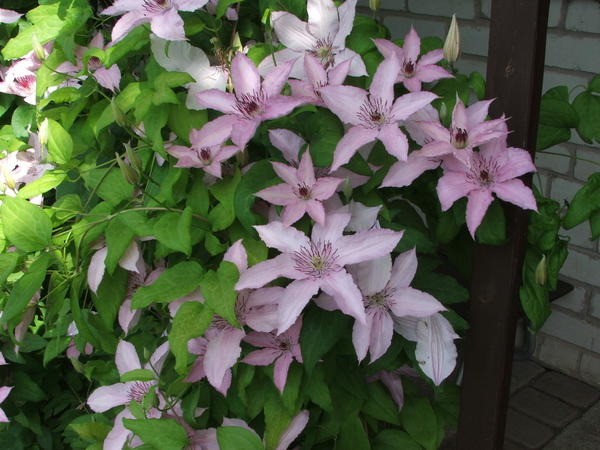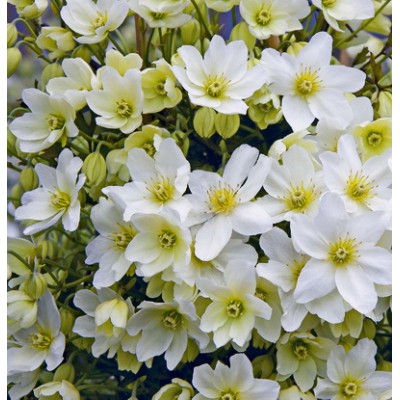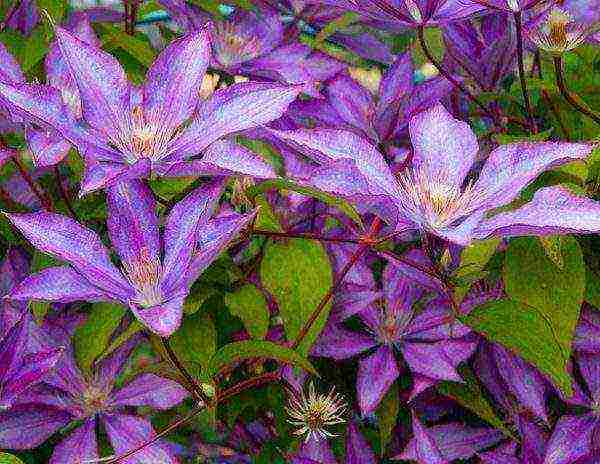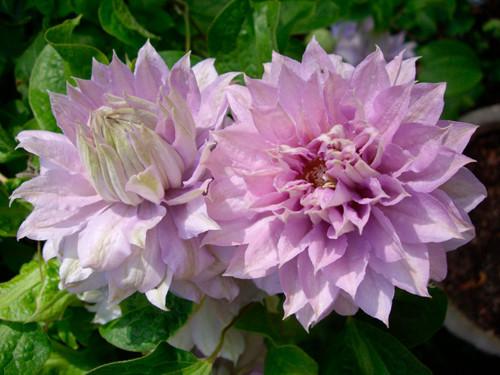Diseases and pests
| 1. Powdery mildew |
Ways to fight:
- treat clematis with Bordeaux liquid in autumn and spring to prevent fungal diseases;
- if a disease is detected, cut off all affected parts of the plant and burn;
- treat the bush and the soil under it with a fungicide
2.Rust
Ways to fight:
- if rust is found, cut off the diseased parts of the plant and burn;
- treat the bush with 1 - 2% Bordeaux liquid or its analogue (copper oxychloride, Oxyhom, Polychom)
3.Fusarium
Ways to fight:
- do not allow the soil to become waterlogged;
- treat the plant prophylactically with 1% copper sulfate solution;
- if a disease is detected, remove all affected leaves and stems and burn;
- treat the bush with Fundazole solution (dissolve 1 g of the drug in 1 liter of water), ash water (1 glass of ash in 1 bucket of water) or powder it with dry ash powder

4.Nematoda.
Ways to fight:
- if affected by a nematode, destroy the plant;
- disinfect the soil where clematis grew;
- in the place where the diseased clematis grew, do not plant any plants for several years
5 aphids
Ways to fight:
- regularly inspect the plant for timely detection of the pest;
- with a small amount of aphids, wash it off with water;
- in case of significant damage, wipe the leaves with a solution of green potassium soap;
- from ready-made preparations, use Fitoverm (2 mg of the drug per 1 liter of water), spraying the plant with it
Growing
A beautiful large-flowered liana is planted in spring, summer, but the best time is September, October.
- For hybrid clematis, choose a sunny place or with light partial shade. Liana does not like strong midday heat, its roots are protected by medium-sized annuals;
- Planting clematis President and the rules of care provide for the placement of large-flowered creepers in a place where there is no stagnation of water or drainage of rain streams from the roofs of buildings. Fertile, permeable soils are suitable. The hybrid plant does not develop well on heavy and acidic soils;
- Large flowers and light shoots of large-flowered clematis will suffer from strong winds, for vines it is best to plant in a sheltered place;
- When placing several vines of vigorous clematis President, one and a half meters recede between the holes.
Sapling requirements
Shoots from containers take root more easily. But if the root system is open, it should be examined. Ideally, the roots of clematis are up to 30 cm long, without thickening and damage. Shoot of clematis President with large buds or leaves that have begun to bloom. Before planting, the roots are soaked in water for several hours. Growth stimulants are also used.
Landing
It is better to dig a hole for clematis with dimensions of 0.6 x 0.6 x 0.6 m in advance so that the earth is settled. A 10-centimeter drainage layer is placed on the bottom. The soil is mixed with a bucket of humus and 0.5 liters of wood ash, complex flower fertilizer, guided by the instructions.
- If clematis President is planted with an open root system, a tubercle is made from the soil and a seedling is installed on it, carefully spreading the roots;
- The root collar and stem are covered with earth so that the lower bud deepens by 5-8 cm, then watered;
- When planting in spring, the large-flowered liana is deepened to the first internode.
In the spring, from the hybrid clematis of autumn planting, a part of the earth is also removed from above, making a deepening so that it is easier for new shoots to germinate from a still weak root.
As soon as the shoots begin to grow, they must be carefully tied to the support, directing them in the right direction. Some of the shoots of large-flowered liana are directed horizontally so that the flowering covers the entire decorative lattice.Abundantly flowering clematis The President requires systematic care in order to delight the gardener with good development. The hybrid liana is provided with weekly watering, and in the heat - 2-3 times a week. The first year, 10-20 liters of water are poured at a time, a grown large-flowered plant is given a double volume - up to 40 liters. After watering, the soil is loosened, on hot days a layer of mulch from weeds and grass is laid.
In the spring, hybrid clematis is treated with fungicides for prophylaxis. In the summer, when aphids and spider mites appear, insecticides and acaricides are used.
Top dressing
If possible, clematis is given organic fertilizing by the President. For the winter, humus is poured onto the hole, in the summer 3-4 times it is poured with liquid solutions of mullein or bird droppings. A large-flowered plant is fertilized with minerals 3 times:
- With the onset of development, vines are dissolved in 10 liters of water 30-40 g of urea. Consumption - 5 liters per bush;
- In the flowering phase, clematis President is fertilized with a solution of 30-40 g of nitrophoska and 20 g of potassium humate per 10 liters. Consumption - a bucket per bush;
- After flowering, the vine is maintained with a solution of 40 g of superphosphate and potassium sulfate in 10 liters of water. Consumption - half a bucket per hole. Superphosphate is soaked per day in a liter of hot water, and then diluted to normal.
There are many different offers of flower fertilizers in the trade network, which can also be used. Organic mineral fertilizers "Ideal" and other preparations of this type are beneficial for the hybrid liana President.
Pruning
To regulate the flowering process, shoots are cut twice in large-flowered clematis of the 2nd pruning group. Clematis President belongs to her. Having given the first wave to bloom, they cut off at the base all the shoots of the last year. In September, the shoots that have grown since spring are cut off. There are two options for this trim. If the entire shoot is cut to the root, there will be no early flowering next spring. In order for clematis to bloom in June, only the generative part, where the flowers were, is cut off on the shoots of the current year.
Preparing for winter
Winter hardiness of clematis President is high, but in the conditions of central Russia, the plant is covered. In autumn, peat, fallen leaves, sawdust are placed in the projection of the hole. Liana is removed from the support and carefully folded. With the onset of frost, spruce branches or dry remains of garden and flower plants are placed. Open gradually in warm weather.
A spectacular large-flowered liana will respond to careful care with beautiful flowering. Feeding and protecting the plant from frost, the gardener will admire the purple stars for years.
Plant in sunny or light shade
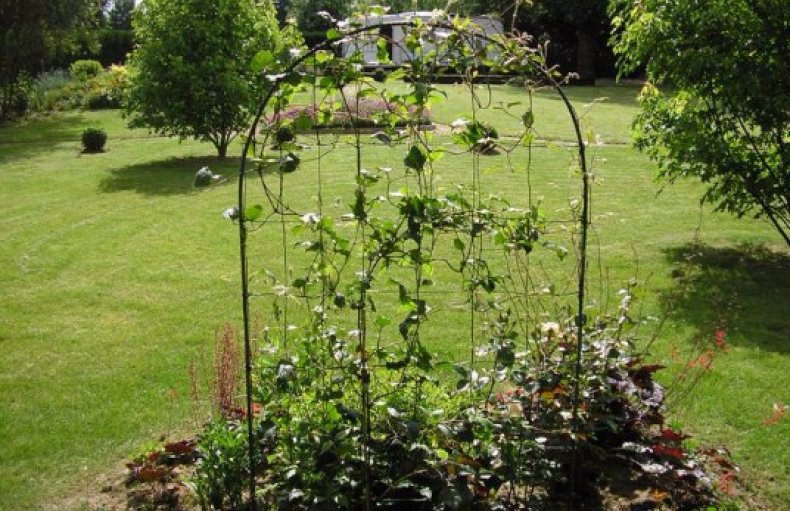 Clematis Ville de Lyon must be provided with reliable support.
Clematis Ville de Lyon must be provided with reliable support.
Choose a sunny place for planting, well protected from drafts and wind. If clematis is planted in the openwork partial shade of trees, its flowers will retain a bright color.
Before planting, build a vertical support for the clematis. These can be various specially made structures, as well as fences, walls or gazebos. The support should be about 2 m high and 1.5 m wide, made of sturdy material. According to the advice of gardeners, it is convenient to use a netting netting, along which clematis easily climbs along the support.
Choose an area with a low groundwater table, as the plant does not tolerate stagnant water. If this is not possible, plant clematis on a hill.
Provide fertile, water- and air-permeable soil with an alkaline pH.
Dig a planting hole. If there are several plants, keep the distance between the pits at least 80 cm.
Fill it with a layer of expanded clay, broken brick or pebble drainage.
Pour a layer of soil mixture from humus, superphosphate and ash on top. Add an additional 150-200 g of lime to acidic soil;
Place the seedling in a hole, cover it with soil so that the root collar is 7 - 8 cm below ground level.
Cover with soil and tamp lightly.
Water the seedling well.
Mulch the soil around the clematis to keep the root system from overheating. The plant does not tolerate this.For the same purpose, it is good to plant low plants around clematis, which will create shade.
Water the clematis as the soil dries. Watering frequency and amount of water depends on growing conditions and weather
It is important that the soil is moderately moist and that water does not stagnate.
Loosen the soil after watering, weed out the weeds.
Fertilize this variety from the second year after planting three times per season. In the spring, during the active growing season, fertilize with nitrogenous fertilizers
Use mineral complexes for flowering plants. Instead, you can add infusion of mullein or bird droppings. During the budding period, it is also important to feed clematis with mineral mixtures. During flowering, fertilize every 14 days, alternating organic matter with minerals. Before the onset of cold weather, add ash.
Ville de Lyon belongs to the third pruning group (strong), when all shoots are pruned to a height of 20-30 cm from the ground (2-4 internodes remain). Radical pruning allows the plant to be conveniently sheltered for the winter and stimulates lush flowering in the coming season.
The variety is frost-resistant, for wintering it is enough to huddle and cover with peat. But in regions with harsh winters, more serious shelter is required. The plant is removed from the supports and, without cutting, is laid on dry leaves and covered with one layer of non-woven covering material.
Planting and caring for clematis Ville de Lyon is easy and even a novice gardener can do it.
Description of the variety
The Piilu clematis variety can be called relatively new - its selection was carried out at the end of the 20th century by an enthusiast from Estonia named Uno Kivistik. The efforts were not in vain. Having stood the test of time, this large-flowered hybrid cultivar has gained international fame. And its name - Piilu, which means "little duck", sounds today in the mouths of the most famous flower growers.
Clematis of this variety were obtained on the basis of another species, it is called "Sprawling". The hybrid variety is distinguished by its ability to form flower buds from the first year. On plants that bloom for the first time, the buds have a single-row arrangement of petals. Their number varies from 4 to 6.
Among the distinctive features of "Piilu" clematis are:
- small shoot height - only 90-150 cm, depending on the climate;
- climbing type of plant, therefore, it needs support for proper growth;
- color range of buds from pastel lilac to pale pink;
- the presence of a characteristic bright pink stripe in the middle of the flower;
- deep yellow stamens;
- waviness of the edges of the petal;
- the large size of the flower bowl is up to 12 cm with full disclosure.
The flowering of the plant can be called quite abundant. It takes place in 2 waves or more, begins in late spring and lasts until October-November. Clematis "Piilu" of the first year of life blooms later. After 7 years of life, due to the intensive growth of roots, the plant needs additional nutrition, otherwise the size of the buds will gradually decrease.
The Piilu clematis variety is considered frost-resistant - it is successfully grown in the climate of Siberia and the Urals. The plant tolerates frost well enough, is able to overwinter when the temperature drops to -34 degrees Celsius. In a temperate climatic zone, this perennial also does well enough. Its drought resistance is low, the plant needs regular watering, and if there is a lack of water, it can shed leaves and buds.
Reproduction
Clematis can be propagated by seeds and vegetatively. In the first case, it will not be possible to preserve the varietal characteristics of the culture. Most often, gardeners use the vegetative method. It is considered to be less labor intensive and more reliable.
Seeds
Seeds ripen 90 days after the end of flowering. Usually, in Russian regions, clematis seeds do not ripen. This is due to the peculiarities of the climate. In this case, it is recommended to place the branch with fruits in a vessel with water and place it on the windowsill.This will give you the opportunity to get seeds.
Cuttings
This method is recommended for reproduction in June. The procedure should be carried out during the formation of the buds. In this case, it is necessary to cut off the middle part of the shoot of a young plant aged 2-3 years and cut into pieces. There should be 2 centimeters above the internode, and 3-4 below.

After that, it is recommended to put the cutting in Kornevin's solution, then move it to a separate glass. The culture does not take root for 3 months.
Layers
First you need to select powerful shoots of the plant and dig out furrows for them 5 centimeters deep. Then lay the vine along the grooves and fix it with staples. Top shoots should be sprinkled with fertile soil and watered.
Shoots will take root during the season. In autumn, it is recommended to cover them with a mulch layer. In April or May of next year, it is permissible to move the bushes to a permanent place. This method of propagation is time-consuming, but allows you to get several bushes at the same time.
Dividing the bush
When clematis roots grow, it is recommended to dig up on one side and separate a root fragment with 2-3 shoots. It is recommended to completely remove the young bush from the ground. Delenka should be immediately dropped into the prepared recess. This is a simple and quick method. However, it does not allow you to get a large number of bushes.
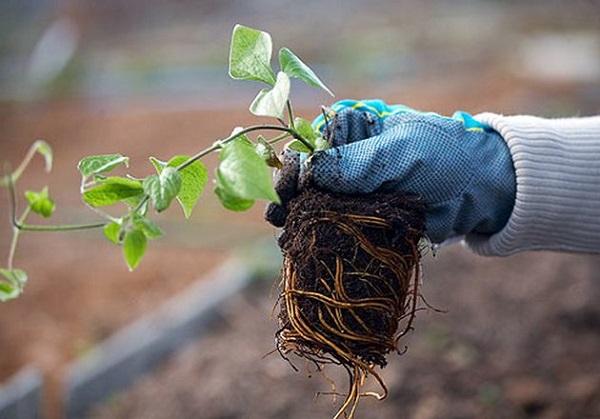
Reproduction
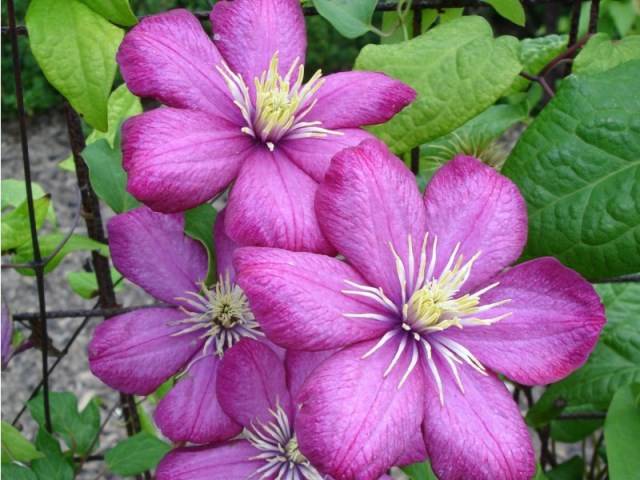 Close up of clematis flower
Close up of clematis flower
- Green cuttings
By cuttings, ville de lyon is propagated during the budding period, this is the period from the end of May to the whole of June. Cuttings are taken from the middle part of the shoot, cut into segments with one internode and two leaves. Below the internodes leave 3-4 cm, above 1-2 cm.
- Layers
The easiest and most reliable breeding method. In the grooves prepared by the ville de lyon bush, 5-7 cm deep, shoots are laid. Shoots are pinned to the ground, covered with light nutritious soil and watered. Over the summer, a well-developed shoot with its own root system is formed from each internode. It is better to separate and plant the layers next spring. For the winter, the site with layering must be mulched.
- By dividing the bush
When dividing old, powerful bushes, they are not removed from the ground, so as not to severely injure, but part of the rhizome with shoots is separated and planted.
There are 3 ways to breed a variety. Reproduction occurs:
- By cuttings;
- Layers;
- By dividing the bush.
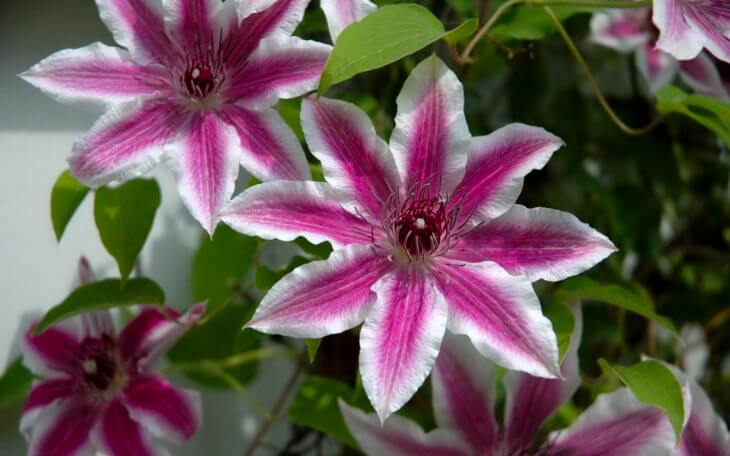
Clematis photo
Reproduction in the first way is carried out in the first month of summer. Cuttings are taken from the middle part of the process, they are cut into segments with one internode and two leaves. We leave 3 cm below the internode, and no more than 2 cm above.
The second method is considered the simplest and most reliable. Shoots are placed in grooves prepared in advance for the plant (5-7 cm). They are pinned to the ground, soil is added from above and watered. During the summer season, grow a shoot with a developed rhizome from each internode. Sharing is recommended next spring. In winter, a plot with layering is mulched.
When dividing a bush, a young plant is dug up and several parts are divided, and each of them must have at least 2 shoots.
When dividing an old plant, it is not removed from the soil, but only a part of the root system with shoots is separated and transplanted.
Dividing the bush
Clematis with an overgrown root system is undermined on one side, a part of the root with two or three shoots is separated with a shovel. A young plant is completely removed from the ground before reproduction.
The delenka is immediately planted in a prepared pit.
The method is considered the simplest and fastest, but it is impossible to get many new plants from an adult bush.
Layers
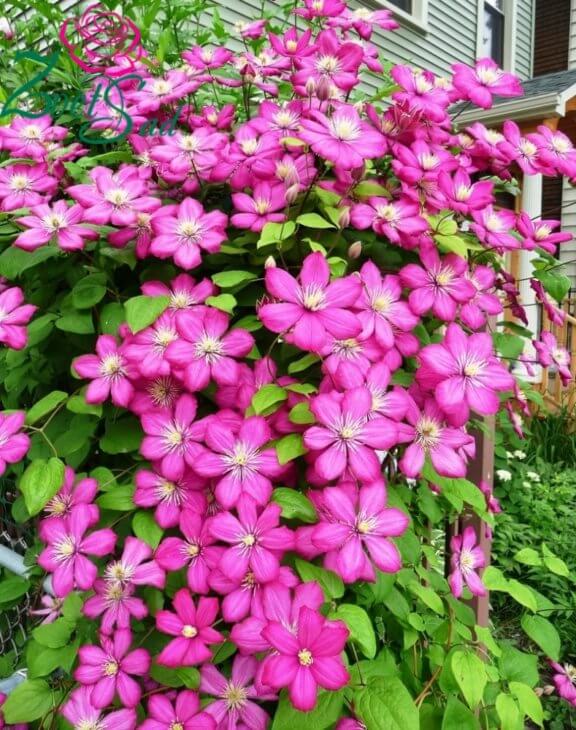
Dig 5 cm grooves for the selected clematis shoots. Lianas are laid along the grooves, fixed with metal or wooden staples, covered with fertile substrate, watered.
During the season, young shoots of Ville de Lyon clematis grow with their roots, which are mulched in autumn. A transplant to a permanent place is done in April-May next year.
Cuttings
Clematis is propagated by cuttings in June during the budding period. Cut out the middle part of the shoot of a young bush 2-3 years old. Cut segments slightly larger than one internode so that 2 cm remains on top, and 3-4 cm below the internode.
The petiole is placed in Kornevin's solution, planted in a separate glass. The rooting process takes three months.
Seeds
Seeds ripen 90 days after flowering stops. In most Russian regions, climatic conditions impede the formation of full-fledged planting material. In this case, a branch with fruits is placed in a vessel with water and placed on a windowsill until conditioned seeds are formed.




